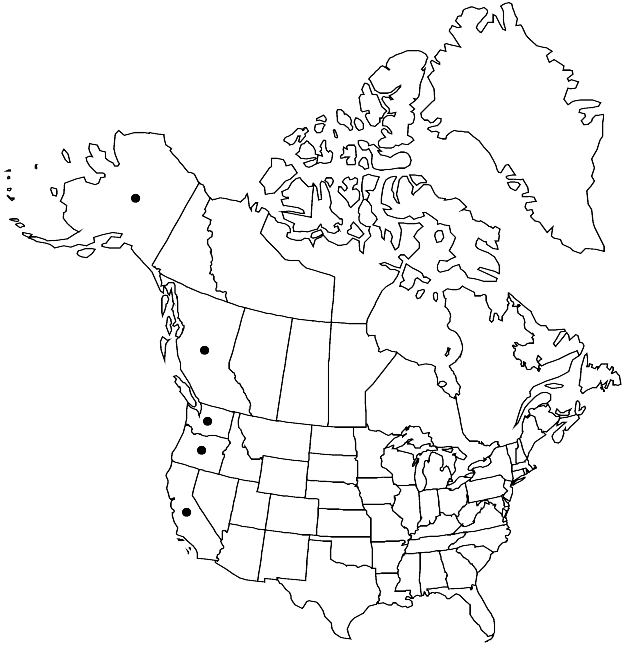Homalothecium nuttallii
Ber. Thätigk. St. Gallischen Naturwiss. Ges. 1876 – 1877: 310. 1878.
Plants small to medium-sized, in dense tufts, light green when young, golden or brownish yellow with age. Stems to 5 (–10) cm, densely pinnate, branches 3–5 mm, curved and secund away from substrate. Stem-leaves erect-appressed, ± homomallous, triangular-lanceolate, 1–2 (–2.5) × (0.2–) 0.4–0.7 (–0.8) mm; base short-rounded, narrowly decurrent; margins plane or often recurved in places, minutely serrulate to subentire, teeth in alar region small, conspicuous, recurved; apex long-acuminate, acumen filiform, providing hyaline-villous aspect; costa to 70–90% leaf length, often vanishing in plication, terminal spine sometimes present; alar cells subquadrate, 6–7 µm wide, region of 6–9 × 5–8 cells, distinctly delimited, not reaching margins; laminal cells linear-flexuose, 35–95 × 4–6 µm; basal-cell shape irregular, short, region in 2 rows, indistinctly delimited from more distal cells. Branch leaves appressed when dry, spreading when moist, narrowly lanceolate, (0.5–) 0.7–1.7 × (0.1–) 0.2–0.4 mm; margins plane or recurved at places, serrulate or serrate proximally, entire or minutely serrulate distally, teeth in alar region conspicuously recurved; apex acuminate; costa to 70–90% leaf length, disappearing in acumen, terminal spine sometimes present; alar cells subquadrate, 6–7 µm wide, region small, distinctly delimited; laminal cells linear-flexuose, 25–85 × 4–6 µm; basal-cells in 1 (or 2) rows; distal cells smooth. Sexual condition phyllodioicous or dioicous. Seta 0.7–1.5 cm, rough. Capsule erect, cylindric, sometimes slightly curved, 2–2.5 mm; annulus separating by fragments; operculum long-conic; peristome hygrocastique; exostome teeth with long transitional zone; endostome basal membrane high, segments as long as teeth, very narrow, cilia very short or absent. Spores dimorphic; 10–14 µm or 16–20 µm.
Habitat: Epiphytic on trunks and branches of hardwood trees and Douglas fir, forests and open stands, especially Quercus garryana, rock, rotten logs
Elevation: low to high elevations (0-1600 m)
Distribution

B.C., Alaska, Calif., Oreg., Wash.
Discussion
A. J. Grout (1928–1940, vol. 3) reported Homalothecium nuttallii from Idaho and Montana, but H. Hofmann (1998) found that these specimens are H. nevadense. E. Lawton (1965) did not cite H. nuttalii for these states. The species can be recognized in the field by the relatively narrow, leafy branches. Also, the branch leaves are distally filiform and, when dry, look hyaline-villous, resembling species of Fabronia. Under the microscope, the recurved teeth of leaf margins allow immediate species identification. The branch leaves may be straight, homomallous, or falcate-secund; the small spores are smooth, the larger papillose.
Selected References
None.
Lower Taxa
"long" is not a number."broad" is not a number.
